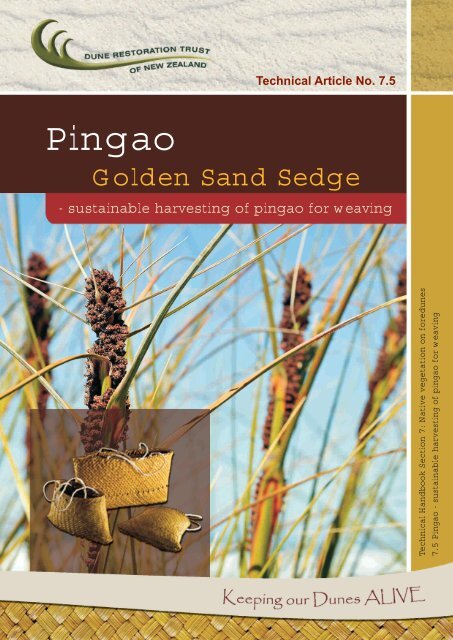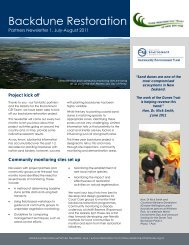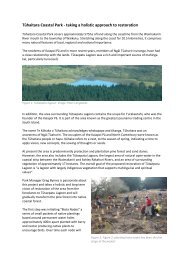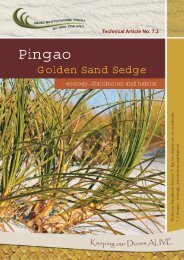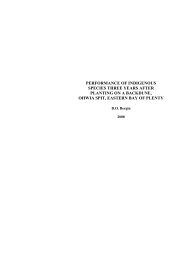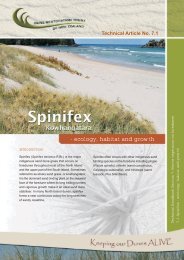Pingao sustainability for weaving - Dune Restoration Trust
Pingao sustainability for weaving - Dune Restoration Trust
Pingao sustainability for weaving - Dune Restoration Trust
You also want an ePaper? Increase the reach of your titles
YUMPU automatically turns print PDFs into web optimized ePapers that Google loves.
<strong>Pingao</strong><br />
Technical Article No. 7.5<br />
Golden Sand Sedge<br />
- sustainable harvesting of pingao <strong>for</strong> <strong>weaving</strong><br />
Technical Handbook Section 7: Native vegetation on <strong>for</strong>edunes<br />
7.5 <strong>Pingao</strong> - sustainable harvesting of pingao <strong>for</strong> <strong>weaving</strong>
INTRODUCTION<br />
Article No. 7.5 - <strong>Pingao</strong> - sustainable harvesting<br />
<strong>Pingao</strong> (Ficinia spiralis), sometimes called golden<br />
sand sedge, is one of our native sand binding<br />
plants found growing on <strong>for</strong>edunes throughout<br />
New Zealand. <strong>Pingao</strong> was the dominant sand dune<br />
plant in the South Island and Stewart Island (where<br />
it is known as pikao), and shared that position with<br />
kowhangatara (Spinifex sericeus) in the North Island<br />
(Herbert and Oliphant, 1991).<br />
<strong>Pingao</strong> has an established status among Maori<br />
weavers. It is one of four natural fibres extensively<br />
used <strong>for</strong> <strong>weaving</strong> by Maori, the other three being<br />
harakeke or flax (Phormium tenax), ti kouka or<br />
cabbage tree (Cordyline australis) and kiekie<br />
(Freycinetia banksia). The leaves of pingao are<br />
highly prized in traditional <strong>weaving</strong>, being the only<br />
natural fibre with a colour which cannot be improved<br />
upon. It sun-dries to a brilliant orange-gold shade<br />
and needs no further processing (Herbert and<br />
Oliphant, 1991). Weavers use pingao <strong>for</strong> patterning<br />
highlights – the orange-gold leaves provide a vibrant<br />
contrast to the black-dyed or natural pale hues of<br />
harakeke and kiekie. A familiar sight is pingao<br />
combined with kakaho, kiekie and harakeke in<br />
tukutuku panels on the walls of wharenui. The leaves<br />
are also used on their own or with other <strong>weaving</strong><br />
materials to make fine plaited kete (bags), whariki<br />
(mats), potae (hats), pare (headbands), belts and<br />
raincapes (Sue Scheele, Landcare Research, pers.<br />
comm.).<br />
The fine plaited kete or bags using<br />
natural golden pingao fibre.<br />
Handles are made from the lighter<br />
coloured harakeke fibre.<br />
2<br />
The natural golden pingao provides a contrast to other fibres on<br />
a tukutuku.<br />
Today, most of the natural <strong>for</strong>edune systems in<br />
New Zealand have been heavily modified or<br />
destroyed completely. Fire, grazing by farm stock,<br />
browsing by wild animals particularly rabbits, and<br />
competition from introduced plants have led to the<br />
decline of pingao and even loss of the species from<br />
many beaches. The exotic sand binding plant marram<br />
grass (Ammophila arenaria), introduced to control<br />
large-scale erosion over a century ago, has displaced<br />
pingao in many regions (Partridge, 1991; Johnson,<br />
1992).<br />
In the past the harvesting of pingao was governed<br />
by Maori tikanga, but more recently, in some areas,<br />
inappropriate methods of harvesting fibre could have<br />
also contributed to the decline of natural stands of<br />
pingao.
LOSS OF PINGAO<br />
Article <strong>Dune</strong>s No. <strong>Trust</strong> 7.5 Handbook - <strong>Pingao</strong> - Article sustainable No. 6 harvesting<br />
- Fences on Coastal Sand <strong>Dune</strong>s<br />
During the 1990s Coast Care programmes<br />
were set up in several regions focussing<br />
on restoring indigenous biodiversity<br />
including pingao.<br />
In many districts pingao was<br />
becoming limited toward the end<br />
of last century to sustain the demand<br />
<strong>for</strong> pingao fibre (Courtney, 1984). Weavers<br />
interviewed in several regions throughout the country<br />
also indicated the loss of pingao (Herbert and<br />
Oliphant, 1991). These kuia, many of whom were<br />
in their 80s, suggested that it was the establishment<br />
of marram grass and the increase in exotic<br />
production <strong>for</strong>estry on coastal sand dunes that<br />
displaced the pingao. They also indicated preferred<br />
methods <strong>for</strong> harvesting pingao and how to encourage<br />
its growth. But the most consistent theme from the<br />
weavers was the need <strong>for</strong> pingao to be cultivated<br />
as a <strong>weaving</strong> resource. To achieve this, in<strong>for</strong>mation<br />
is required by local communities on methods <strong>for</strong> reestablishing<br />
pingao on sand dunes with a focus on<br />
education - “teaching people about pingao.”<br />
3<br />
The resurgence in traditional <strong>weaving</strong><br />
during the 1980s saw increasing interest<br />
in the special cultural qualities of pingao as<br />
a natural fibre. During the 1990s Coast Care<br />
programmes were set up in several regions<br />
focussing on restoring indigenous biodiversity<br />
and natural dune <strong>for</strong>m and function to degraded<br />
coastal <strong>for</strong>edunes using native plants. This included<br />
the use of the key native sand binder pingao.<br />
As described by Herbert and Oliphant, (1991):<br />
The cultural, spiritual, and traditional significance<br />
to Maori people is behind the drive in ef<strong>for</strong>ts to<br />
maintain and nurture this valuable plant. As the<br />
children of Papa-tu-a-nuku were able to bring together<br />
the child of Tangaroa and the child of Tane Mahuta<br />
in the meeting house, so humans need to intervene<br />
now <strong>for</strong> the children of Tane.
While restoration programmes are underway in many regions to restore <strong>for</strong>edunes with pîngao with the potential<br />
to provide a sustainable <strong>weaving</strong> resource, it may be easier to establish gardens specifically <strong>for</strong> harvesting of<br />
fibre. Weavers can build up their own resources of pingao in a home or community garden. This obviates the<br />
need to seek permission to harvest from natural populations. In some regions where pingao is not well established<br />
or where quantity and vigour of plants varies from year to year, a well-tended and planned cultivated garden of<br />
pingao is likely to give you a more secure supply of fibre.<br />
<strong>Pingao</strong> does not need sand!<br />
<strong>Pingao</strong> does not need a sand dune to grow; in fact pingao does not need to grow in sand – it can grow effectively<br />
in a wide range of moist, well-drained soils. Sand should be added to lighten heavy soils. <strong>Pingao</strong> seedlings are<br />
usually raised in root trainers from seed and are available from commercial or community-based nurseries in<br />
many regions. The methods <strong>for</strong> establishing pingao on sand dunes given in the <strong>Dune</strong> <strong>Restoration</strong> <strong>Trust</strong> of<br />
New Zealand Handbook Technical Article No. 7.2 can be used <strong>for</strong> planting pingao in gardens. The key requirement<br />
at planting is to incorporate a small handful of slow-release NPK fertiliser or a fertiliser tablet.<br />
Caring <strong>for</strong> your pingao garden<br />
Once seedlings are established (about three months after planting), a light application of<br />
high N fast-release fertiliser (such as Urea) will promote faster growth. Summer watering<br />
and application of mulching materials such as sawdust, leaf litter, bark or straw will maintain<br />
necessary moisture levels and suppress weed growth. Deep mulch will encourage long<br />
leaves, improving their utility <strong>for</strong> <strong>weaving</strong> (Sue Scheele, Landcare Research, pers.comm.).<br />
Although it will grow in semi-shade, full sun will develop the rich golden colours <strong>for</strong> which<br />
pingao is prized.<br />
Maintaining quality and quantity of fibre<br />
As pingao is a sand binder, sustained vigorous growth is achieved <strong>for</strong> natural stands by<br />
a constant supply of wind-blown sand being trapped by its leaves resulting in dune building.<br />
In a garden, pingao will eventually lose vigour, and while occasional light dressing of fastrelease<br />
fertiliser will boost growth, depending on growth rates and the site, plants after<br />
two to three years may become unthrifty as long spreading rhizomes develop and the<br />
garden becomes dominated by large sprawling plants. Older plants with large terminal<br />
leaf clusters dominated by curved leaves may yield lower quantities of straight leaves<br />
favoured <strong>for</strong> <strong>weaving</strong>. It may be necessary to replace a proportion of plants every three<br />
years or so to ensure an ongoing supply of fibre from young vigorous plants with straight<br />
leaves.<br />
Choice of pingao<br />
Grow Your Own <strong>Pingao</strong> Garden<br />
Provenance trials indicate substantial differences in length of leaves of pingao growing<br />
in different regions of New Zealand. Provenances (used here to specify the place of origin<br />
of a pingao population), show important differences in the <strong>weaving</strong> properties of the leaves<br />
(Bergin and Herbert, 1999). These relate to leaf length and width, roughness, straightness,<br />
and bending strength. For instance, some pingao populations (e.g., Port Waikato and<br />
Ocean Beach, Napier) tend to have a sprawling rhizomatous habit; others (e.g., provenances<br />
from the west and south of the South Island) are more erect plants with many basal tillers<br />
<strong>for</strong>ming a tussock-like plant.<br />
While local restoration programmes are encouraged wherever possible to restore their<br />
dunes using plants raised from locally sourced seed, weavers have the option of including<br />
pingao from other regions in their gardens where the garden is located well away from<br />
natural populations. Note that there is a marked difference in frost tolerance between<br />
provenances where pingao from northern latitudes may not grow in cooler regions, so<br />
care in choice of provenance and garden location will be required. While further work is<br />
required on determining differences in fibre quality between provenances of pingao, a<br />
garden gives weavers the option of raising pingao from different regions.<br />
4
SUSTAINABLE HARVESTING TRIALS<br />
The effects of different harvesting methods on plant<br />
vigour, and the quantity of useful fibre obtained,<br />
have been evaluated in field trials on natural<br />
populations growing on the Bay of Plenty and<br />
Manawatu - Rangitikei dune systems. Three<br />
harvesting methods were compared:<br />
Cutting – the most commonly used harvesting<br />
method by weavers in which the whole leaf cluster<br />
is severed from the rhizome;<br />
Wrenching – a technique sometimes used by<br />
weavers but difficult to undertake, in which the<br />
centre portion of a leaf cluster is removed by<br />
bending and pulling; and<br />
Clipping – a harvesting method only occasionally<br />
used in which leaves of high quality are selected<br />
and cut individually from leaf clusters.<br />
The three harvesting methods were tested on lateral<br />
leaf clusters borne at regular intervals along a<br />
rhizome but only the cutting method was tested on<br />
terminal leaf clusters.<br />
COMPARING HARVESTING METHODS<br />
The results showed clearly that survival of the<br />
main growing shoots, and retention and<br />
production of juvenile shoots were highest<br />
when the clipping method was used<br />
(Figure 1). It was also found that:<br />
Clipping did not affect leaf cluster survival,<br />
whereas wrenching and cutting resulted in<br />
severe mortality;<br />
Although all methods produced the same<br />
number of large <strong>weaving</strong> quality leaves<br />
(about 10 per cluster), cutting and wrenching<br />
involved unnecessary harvesting of<br />
unwanted material, and caused destruction<br />
of growing shoots;<br />
Typical numbers of leaves taken in each<br />
operation were:<br />
- 50-100 with cutting method<br />
- 25-35 with wrenching<br />
- 7-35 with clipping<br />
Article No. 7.5 - <strong>Pingao</strong> - sustainable harvesting<br />
5<br />
Cutting technique.<br />
Cutting of whole shoots, or wrenching can cause more damage<br />
than the clipping technique shown below, and can result in<br />
wastage as the leaves will not be suitable <strong>for</strong> <strong>weaving</strong>.<br />
Clipping technique.<br />
The curved leaves of terminal leaf clusters (left) are less favoured<br />
<strong>for</strong> <strong>weaving</strong> than the straight leaves growing in lateral clusters<br />
(right).
Article No. 7.5 - <strong>Pingao</strong> - sustainable harvesting<br />
In the Bay of Plenty trial, no difference was found<br />
between summer and autumn harvesting in terms<br />
of quantity and quality of <strong>weaving</strong> leaves taken from<br />
the same area. Autumn harvested leaves were<br />
slightly longer (49.8 cm) than summer harvested<br />
leaves (45.4 cm). Summer harvested clusters had<br />
twice as many juvenile (immature) leaves (40.2) as<br />
autumn harvested clusters (21.4).<br />
Weavers found that on some plants a higher<br />
proportion of leaves from leaf clusters at the ends<br />
of rhizomes (terminal) were curved compared to<br />
leaves growing in clusters originating along rhizomes<br />
(lateral). Curved leaves are not favoured <strong>for</strong> <strong>weaving</strong><br />
as they distort <strong>weaving</strong> patterns and cause uneven<br />
tension and layout of woven products. The clipping<br />
technique allowed <strong>for</strong> the selection of leaves most<br />
preferred to provide fibre <strong>for</strong> <strong>weaving</strong> – long and<br />
straight.<br />
As only a small proportion of leaves need to be<br />
collected from each leaf cluster using the clipping<br />
method, most of the plant remains intact. This<br />
method there<strong>for</strong>e allows <strong>for</strong> sustainable harvesting<br />
of fibre <strong>for</strong> <strong>weaving</strong> of natural populations of pingao<br />
on our sand dunes without any detrimental effect<br />
on dune stability.<br />
HARVESTING OUTER LEAVES<br />
A further method favoured <strong>for</strong> harvesting fibre by<br />
some weavers, is to carefully strip the outer leaves<br />
from leaf clusters. Single leaves can be pulled off<br />
clusters using a downward motion. This method<br />
was not included in the harvesting trials so the effect<br />
on the remaining plant is not known. However, it is<br />
likely that removal of small numbers of outer leaves<br />
will not significantly affect per<strong>for</strong>mance.<br />
The outer leaves will be the oldest and often the<br />
longer leaves of the cluster but there is likely to be<br />
a higher proportion of more curved leaves than<br />
leaves in the centre of the cluster. Older leaves will<br />
also have more blemishes not favoured by weavers<br />
including blotchy colouring, browsing damage by<br />
6<br />
Survival (%)<br />
No. juvenile shoots<br />
120<br />
100<br />
80<br />
60<br />
40<br />
20<br />
0<br />
1.6<br />
1.4<br />
1.2<br />
1<br />
0.8<br />
0.4<br />
0.2<br />
0<br />
Lateral Leaf Cluster<br />
Unharvested Clipping Cutting Wrenching<br />
Harvesting method<br />
Lateral Leaf Cluster<br />
Unharvested Clipping Cutting Wrenching<br />
Harvesting method<br />
Figure 1: Survival of pingao leaf clusters and number of juvenile<br />
shoots remaining nine months after harvesting.<br />
A favoured method <strong>for</strong> harvesting pingao by some weavers is to<br />
carefully strip outer leaves from established pingao plants. This<br />
method was not included in comparative trials but removal of a<br />
few outer leaves per cluster is not likely to affect plant per<strong>for</strong>mance.<br />
rabbits or other disturbance, and frayed leaf ends<br />
from weathering storms and sand movement.<br />
Care is required in selecting vigorous healthy<br />
clusters that have a high proportion of high quality<br />
outer leaves <strong>for</strong> <strong>weaving</strong>.
Article No. 7.5 - <strong>Pingao</strong> - sustainable harvesting<br />
7<br />
Small and dainty!<br />
While weavers prefer longer leaves <strong>for</strong> kete<br />
(bags), whariki (mats) and potae (hats),<br />
shorter leaves can make a wide range of<br />
smaller decorative items. These can include<br />
ear-rings, putiputi (flowers) and floral<br />
bouquet, brooches or corsages, gift tags,<br />
and small containers and baskets.
Based on these trials, the following recommendations <strong>for</strong> collectors of pingao include:<br />
1. Use the selective clipping method in which only leaves of <strong>weaving</strong> quality are removed from leaf<br />
clusters. Small citrus pruners or sharp scissors should be used.<br />
2. Harvesting of pingao by cutting or wrenching should be discouraged as these methods stop shoot<br />
growth, remove juvenile leaves which are not suitable <strong>for</strong> <strong>weaving</strong>, and cause wasteful removal<br />
of leaves which are subsequently discarded. Repeated harvesting by cutting and wrenching may<br />
contribute to instability of the <strong>for</strong>edune by removal of vegetation cover.<br />
3. Restriction of harvesting to summer or autumn is not likely to result in more, or better quality<br />
<strong>weaving</strong> material.<br />
Protocols <strong>for</strong> harvesting<br />
Be<strong>for</strong>e harvesting leaves of pingao from natural stands on coastal dunes, check <strong>for</strong> protocols from local<br />
iwi and managing agencies. Constraints on the removal of pingao are also imposed by coastal managing<br />
authorities such as the Department of Conservation and Regional and District Councils.<br />
Bergin, D. O.; Herbert, J. W. 1997: Revegetation of sand<br />
dunes in New Zealand using indigenous species.<br />
Proceedings of Pacific Coasts and Ports ‘97<br />
Conference, 7-11 September 1997, Christchurch.<br />
Vol. 1: 425-30.<br />
Courtney, S.1984: Aspects of ecology of Desmoschoenus<br />
spiralis M.Sc. thesis, University of Canterbury.<br />
Johnson, P.N. 1992: The sand dune and beach inventory<br />
of New Zealand II. South Island and Stewart Island.<br />
DSIR Land Resources Scientific Report No. 16.<br />
Department of Scientific and Industrial Research,<br />
Lincoln. 278p.<br />
2011 ISSN 2230-6919<br />
Printed by Scion Digital Print Centre, Rotorua<br />
Article No. 7.5 - <strong>Pingao</strong> - sustainable harvesting<br />
RECOMMENDATIONS FOR HARVESTING PINGAO<br />
REFERENCES<br />
Herbert, A.; Oliphant, J. 1991: <strong>Pingao</strong>: the golden sand<br />
sedge. Nga Puna Waihanga, New Zealand Maori<br />
Artists and Writers. Rotorua. 32p.<br />
Partridge, T.R. 1991: The interaction between pingao and<br />
marram on sand dunes. DSIR Land Resources<br />
Contract Report No. 91/65. Department of Scientific<br />
and Industrial Research.<br />
Author: David Bergin, Environmental <strong>Restoration</strong> Ltd<br />
8


